Key takeaways:
- Advocacy in student unions requires inclusivity and representation, engaging diverse voices for meaningful change.
- Addressing opposition is crucial as it refines ideas, fosters open dialogue, and builds trust within the student community.
- Effective communication involves active listening, clarity, and non-verbal cues, enhancing collaboration and understanding.
- Building a support network through relationships, mentorship, and diverse groups amplifies advocacy efforts and strengthens initiatives.
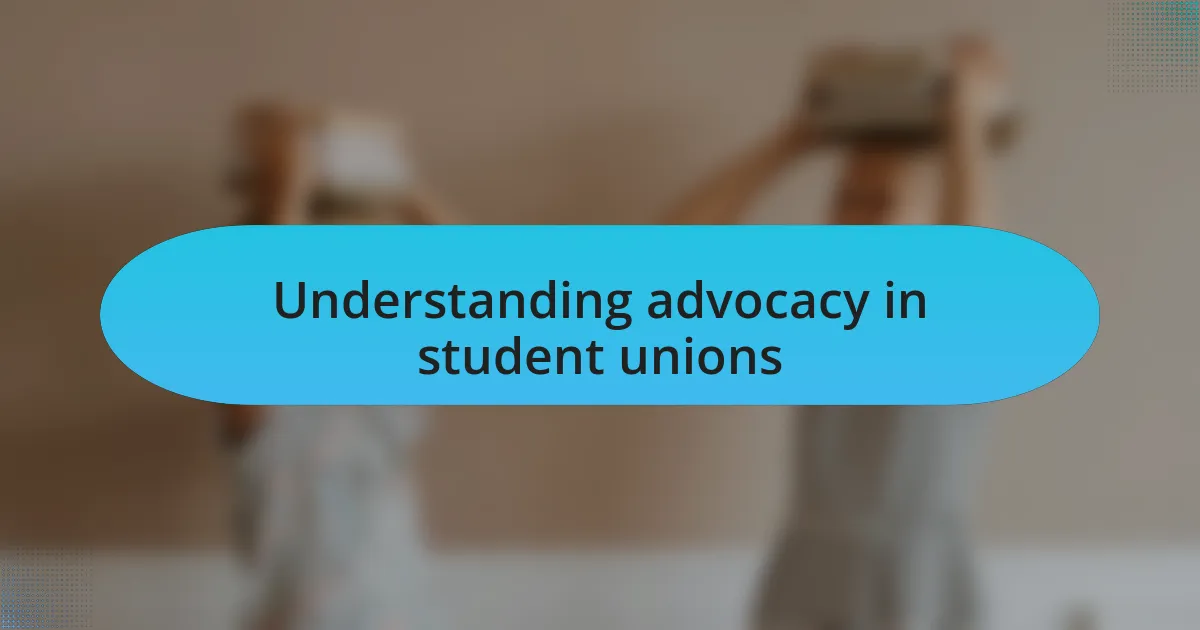
Understanding advocacy in student unions
Advocacy within student unions is not just about voicing concerns; it’s about creating meaningful change. I vividly remember a time when my union rallied for better mental health resources on campus. It struck me how powerful collective voices could be when we united for a common cause.
When I think about it, advocacy is fundamentally about representation. Are we truly reflecting the diverse voices of the student body? I learned that to be effective, we needed to engage everyone, including those who felt sidelined. It was a humbling experience that opened my eyes to the importance of inclusivity in our efforts.
Participating in advocacy can often feel daunting, especially when facing opposition. I recall a meeting where my proposed initiatives were met with skepticism. However, it was a turning point for me; I learned that opposition isn’t always a setback. Instead, it encourages deeper conversations that can foster even stronger resolutions within the student union.
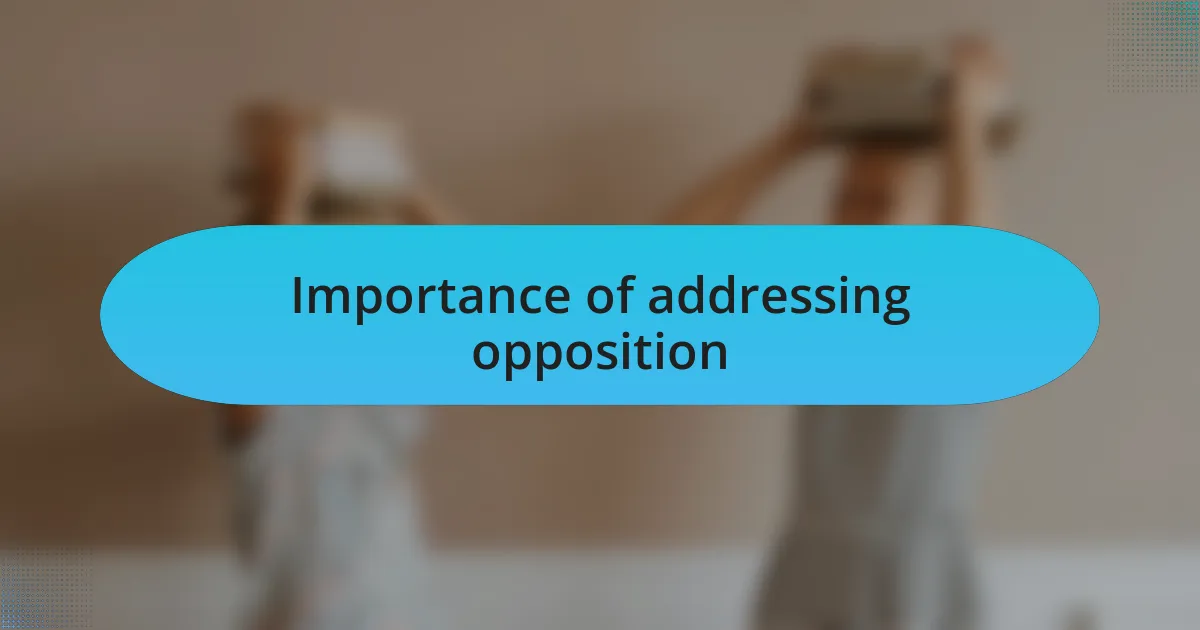
Importance of addressing opposition
Addressing opposition is crucial in advocacy because it provides an opportunity to refine ideas and arguments. I recall presenting a proposal for expanded study spaces only to be met with critical questions about funding and feasibility. Initially, I felt discouraged, but those discussions forced me to dig deeper into our budget and present more compelling evidence. This process ultimately strengthened my resolve and enhanced my advocacy skills.
Engaging with opposing viewpoints can be uncomfortable, yet it fosters a culture of open dialogue. During one session, a fellow student challenged my perspective on inclusivity initiatives for marginalized groups. At first, I was taken aback, but their insights pushed me to reflect on our approach. It was a genuine moment of growth that reminded me how diversity of thought is essential for robust solutions.
Moreover, addressing opposition can build trust within the student community. When I embraced criticism openly, many in the room began to share their own divergent opinions. This candid exchange of ideas not only created a sense of camaraderie but also highlighted that we’re all invested in the welfare of our fellow students. Isn’t it fascinating how opposition can transform into collaboration when we choose to address it head-on?
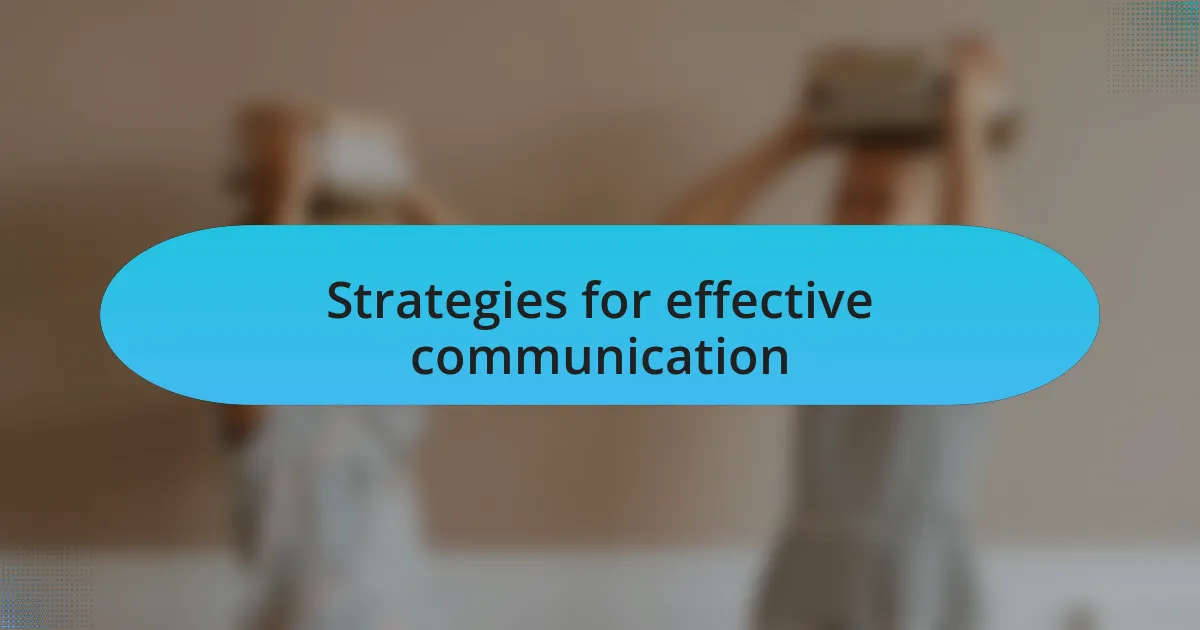
Strategies for effective communication
Effective communication in advocacy hinges on active listening. I remember a time during a heated debate about student fees when I intentionally paused to hear the concerns of others before responding. This allowed me to understand their perspectives better and address their worries, turning a potentially combative situation into a productive discussion. Have you ever noticed how simply hearing someone out can diffuse tension and create a more collaborative environment?
Clarity is another crucial component. I’ve learned that drafting messages that are concise and straightforward can significantly reduce misunderstandings. When my team proposed new health initiatives, I took extra time to simplify our goals and break them down into actionable steps. By ensuring that everyone was on the same page, we fostered a sense of unity and purpose, which was instrumental in gaining broader support.
Additionally, non-verbal cues can enhance your communication strategy. I recall during a presentation, being mindful of my body language and maintaining eye contact with the audience. This connection seemed to relax my peers and encouraged them to engage more openly. Have you ever noticed how a simple nod or smile can invite someone to share their thoughts? It’s those subtle signals that often convey our sincerity and build rapport in advocacy discussions.
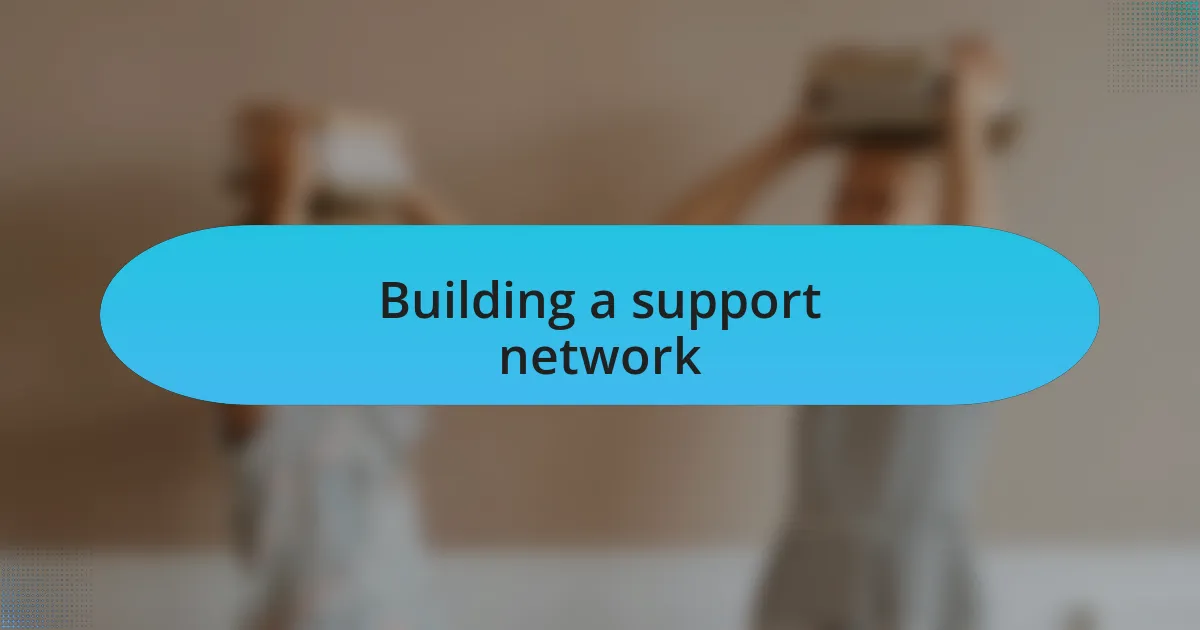
Building a support network
Creating a strong support network is vital in advocacy, and it often starts with building genuine relationships. I vividly remember attending a campus event where I struck up a conversation with a fellow student who shared my passion for sustainability. By connecting over our common interests and challenges, we didn’t just expand our friendship; we laid the groundwork for a powerful partnership in advocating for greener initiatives on campus. Have you experienced the magic that happens when you find someone who truly resonates with your cause?
Additionally, it’s important to seek out mentors who can offer guidance and support. During my time as a student leader, I reached out to a professor who had experience in community organizing. Their insights were invaluable, and I often found myself referencing our discussions when tackling tough issues. Mentorship can illuminate pathways you might not have considered otherwise. How often do you actively seek advice from those who have been in your shoes?
Lastly, I recommend participating in various groups and organizations, as this can significantly broaden your network. I joined a student coalition that focused on social justice, and the diverse perspectives I encountered shaped my understanding of advocacy. These interactions not only provided a wealth of ideas but also fostered a sense of belonging. Have you thought about how engaging with different communities could enhance your advocacy efforts? Embracing diversity within your support network can ultimately amplify your voice and strengthen your initiatives.

Personal experiences with opposition
Facing opposition during my advocacy efforts has definitely been a challenging experience, yet it has also fueled my determination. I recall a specific incident where I presented a proposal for a new mental health resource on campus. Some faculty members dismissed it, questioning the need for additional support despite the rising stress levels among students. How do you react when your passion seems to fall on deaf ears? In that moment, I realized that understanding their reservations was key to moving forward.
I vividly remember a heated debate in a student assembly when my proposal for more inclusive student events received pushback. The opposition stemmed from long-standing traditions that many felt were being challenged. It was disheartening to feel my work being undermined, but it also pushed me to gather more data and stories from students affected by the current policies. Have you ever felt the need to bolster your arguments when faced with skepticism? This experience taught me that equipping myself with real-life impacts can often shift perspectives.
There was one instance that took me by surprise. A fellow student leader publicly disagreed with my stance on an issue during a meeting, which initially felt like a personal attack. Instead of retreating, I approached them afterward to understand their position better. This unexpected dialogue led to a collaborative effort on our next project. Isn’t it fascinating how opposition can sometimes pave the way for unexpected allies? Engaging with my critics taught me the immense value of dialogue and empathy in advocacy.
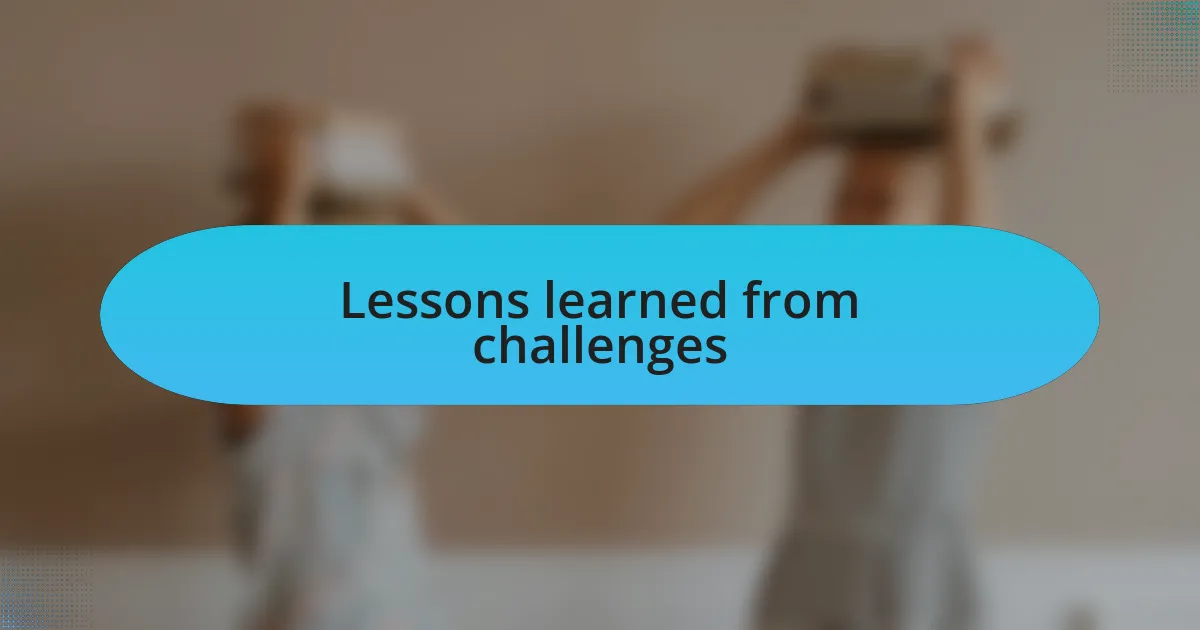
Lessons learned from challenges
It’s surprising how much clarity can emerge from navigating challenges in advocacy. For instance, after facing criticism about my proposal for a more diverse speaker series, I took a step back to analyze the feedback. I realized that some concerns were rooted in a fear of change. This acknowledgment helped me frame my arguments around inclusivity, tapping into shared values rather than creating further division.
In another instance, I organized a forum to discuss the need for expanded student services, but attendance was sparse. Initially, I felt defeated, wondering if my efforts were wasted. However, this challenge taught me the importance of outreach and tailored communication. I learned that understanding the audience’s interests is crucial—if we don’t engage them, our message may never resonate.
Reflecting on these experiences, I can say that confronting opposition isn’t just about defending your viewpoint; it’s about growth and adaptability. There was a time I chose to forgo a confrontational approach in favor of listening sessions. The openness I fostered led to a deeper understanding among all parties, showing me that real change often requires patience and a willingness to adjust our strategies. When have you found that listening paved the way for greater understanding?
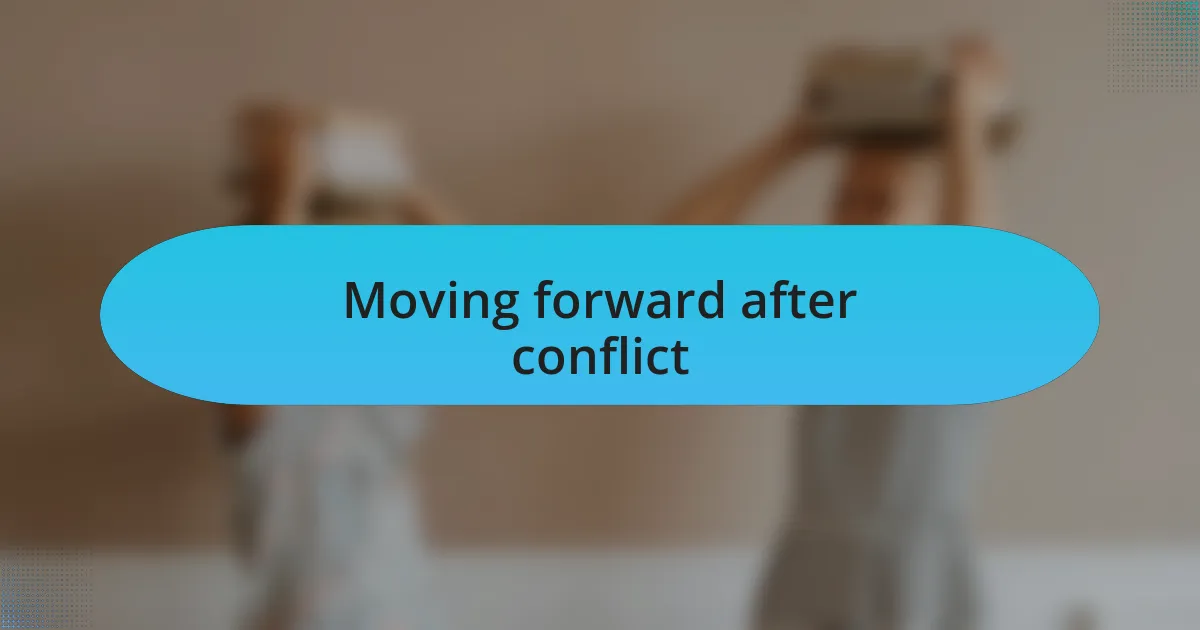
Moving forward after conflict
Once the dust settles after a conflict, the real work begins. I recall a situation where a proposed policy change met fierce resistance, leaving many voices upset. Instead of pushing forward with my agenda, I decided to hold a debrief with all parties involved. It was enlightening to hear their perspectives, and it reaffirmed that moving forward isn’t just about advancing my goals; it’s about engaging the community in healing conversations. How can we truly progress if we don’t first acknowledge the feelings and fears of those around us?
It’s essential to chart a new path after conflict, even if it feels daunting. I remember a time when a disagreement left a rift between student organizations. Rather than allowing this division to linger, I reached out individually to leaders on both sides. We ended up hosting a collaborative event, which not only revitalized our relationships but also reinforced a shared mission. What struck me was that reconciliation didn’t mean compromising my beliefs; it meant working creatively towards a common goal.
In the aftermath of conflict, I’ve learned that flexibility is key. For example, after an intense debate about budget allocations, I chose to revisit my proposal with an open mind. Looking at the other side’s concerns, I adjusted my approach to include some budget compromises that addressed their needs. It was a reminder that progression often involves a dance of compromise and creativity. How often do we consider that making space for others’ needs can lead to innovative solutions for everyone?